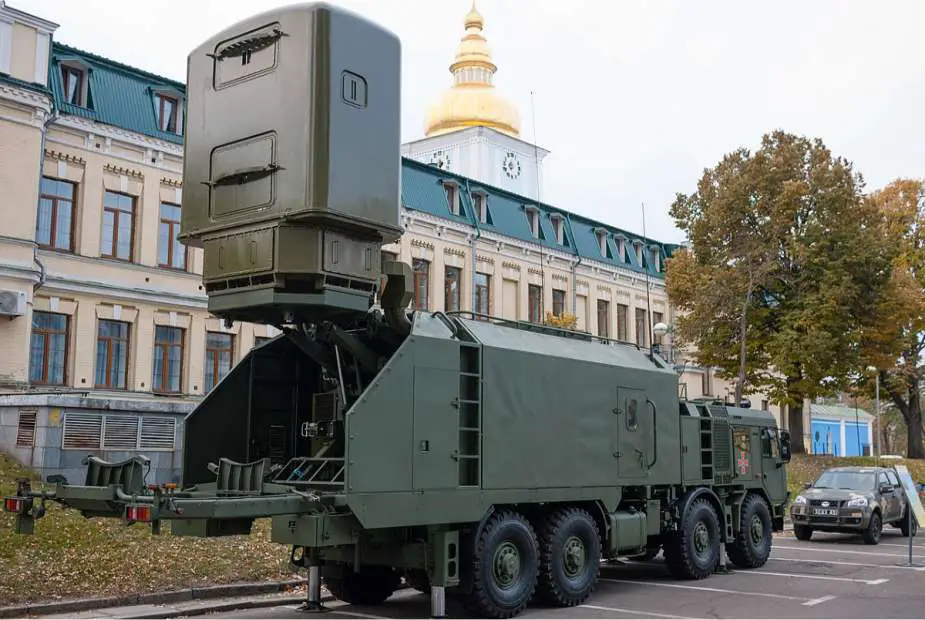Military Equipment Russian-Ukrainian Conflict - Episode 7: Mineral-U Ukrainian Search & Tracking radar
As part of the ongoing examination of military equipment shaping the dynamics of the Russo-Ukrainian conflict, the seventh episode of the Army Recognition series focuses on a Ukrainian search and tracking radar, the Mineral-U.
Follow Army Recognition on Google News at this link

The Mineral-U is a mobile search and tracking radar system developed by the Scientific Research Institute for Radar Technologies "Kvant-Radiolokatsiya". (Picture source: Wikimedia)
In the prolonged conflict between Ukraine and Russia, Ukraine has deployed a series of technological innovations to enhance its defense. One such innovation is the Mineral-U radar system, a crucial tool for detecting and tracking targets beyond the line of sight (BLOS), especially in support of the Neptune anti-ship missile (ASCM) system.
The Mineral-U is a mobile multifunctional, search and tracking radar system developed by the Scientific Research Institute for Radar Technologies "Kvant-Radiolokatsiya," which is part of Ukroboronprom. This system was designed to work with the coastal missile system Neptune, thus enhancing Ukraine's defensive capabilities in the maritime context.
The Mineral-U stands out for its ability to detect and classify surface objects up to a distance of 500-600 km through a passive channel, with further exploration possible via an active channel. Initial tests have verified key technical parameters such as transmitter power, receiver sensitivity, and the mobility of the complex, ensuring its compliance with the required tactical and technical characteristics.
Although the Mineral-U was primarily developed for maritime applications, its presence at military parades and exhibitions in Kyiv demonstrates its growing importance in the Ukrainian arsenal. Its role as a support radar for Neptune ASCM missile batteries positions it as a crucial element in Ukraine's maritime defense strategy against the Russian naval threat.
The Mineral-U project was launched in 2018, and two prototypes mounted on locally produced truck chassis were contracted in December 2019. The radars are designed to be mounted on Tatra truck chassis, due to difficulties with the initial supplier, AvtoKrAZ. The transition to the operational use of Mineral-U radars will depend on future orders, highlighting Ukraine's commitment to strengthening its maritime defense capabilities in the face of challenges posed by the conflict with Russia.
The Mineral-U vehicle is ultimately built on a high-mobility and high-resilience Tatra 8x8 chassis. It offers independent suspension allowing for efficient adaptation to varied terrains encountered in the field. With a payload of 25,000 kg, the 8x8 Tatra chassis is capable of carrying heavy loads over difficult terrain while maintaining high mobility. Its 8x8 transmission configuration ensures optimal traction under varied driving conditions, thus ensuring reliable performance in various environments.
The core of the system is its TATRA T3C-928-90 engine, complying with the EURO 3 standard, capable of delivering a power of 300 kW and a torque of 2,100 Nm at 1,000 rpm. This power is efficiently transmitted through a TATRA 14 TS 210L transmission, a 14-speed semi-automatic transmission.
The vehicle's cabin is designed to offer flexible configuration. The chassis is delivered without a standard Tatra cabin, but with a frame that supports the dashboard, pedals, steering wheel, and seat. Other equipment is provided in spare parts. The cabin tilt mechanism is operated by an electrically controlled hydraulic cylinder, providing easy access to internal components for maintenance and repairs.
With a wheelbase of 2,150 + 2,860 + 1,450 mm and a total laden weight of up to 38,000 kg, the Tatra 8x8 chassis offers an ideal combination of robustness, load capacity, and mobility. Its maximum speed of 115 km/h makes it an efficient choice for missions requiring speed and efficiency in the field.
The Mineral-U is often coupled with the Ukrainian Neptune anti-ship missile system, which has played a notable role in the Russo-Ukrainian conflict, especially in the destruction of the Russian cruiser Moskva in April 2022. This event was a key moment, showcasing Ukraine's ability to effectively use its weapon systems to inflict significant losses on the Russian fleet. The Moskva was the flagship of Russia's Black Sea fleet, and its loss was a severe blow to Russian naval morale and capabilities in the region. This event also underscored the importance of naval warfare in the conflict and demonstrated the effectiveness of Ukrainian defensive capabilities against a numerically and technologically superior force.
The Neptune, based on the Soviet Kh-35 cruise missile, was adapted by Ukraine to meet its specific coastal defense needs. Its success in the engagement against the Moskva not only proved its operational effectiveness but also served as a proof of concept for other Ukrainian-developed weapon systems.
Since this incident, Ukraine has continued to develop and deploy the Neptune system and other indigenous armaments, seeking to bolster its defense against maritime incursions and to deter further aggressive actions by Russia in the Black Sea and beyond. The presence of such capabilities also has implications for the balance of power in the region, altering the dynamics of naval operations and potentially influencing the future strategies of both parties in the conflict.
The development and deployment of the Mineral-U radar system by Ukraine are a testament to the ingenuity and resilience of its defense in the context of a prolonged conflict with Russia. By enhancing maritime target detection and tracking capabilities, the Mineral-U plays a crucial role in Ukrainian defense strategy, offering a technological response to the Russian naval threat and highlighting the importance of innovation in modern warfare.

The Mineral-U vehicle is ultimately built on a high-mobility and high-resilience Tatra 8x8 chassis. (Picture source: Wikimedia)



















